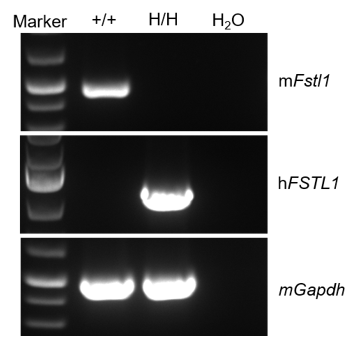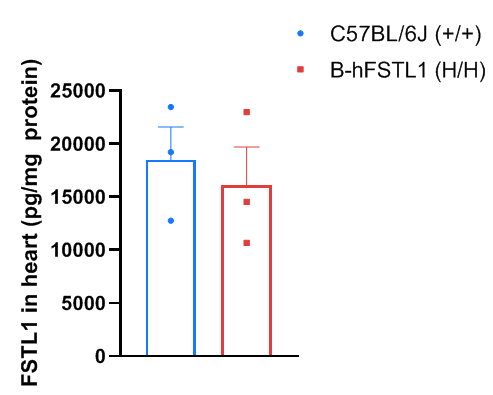B-hFSTL1 mice
| Strain Name |
C57BL/6-Fstl1tm1(FSTL1)Bcgen /Bcgen
|
Common Name | B-hFSTL1 mice |
| Background | C57BL/6 | Catalog number |
112349 |
|
Related Genes |
FRP, FSL1, OCC1, OCC-1, tsc36, MIR198 |
||
|
NCBI Gene ID |
11167 | ||
- FSTL1 is a secreted glycoprotein protein displaying various functions in development and diseases.
- Homozygous mice expressed the human FSTL1 and developed normally.
- This model is useful in safety evaluation for cardiovascular disease and immune disease.
Targeting strategy
Gene targeting strategy for B-hFSTL1 mice. The exons 2-11 of mouse Fstl1 gene that encode the whole molecule (ATG to STOP codon), including 3’UTR were replaced by human counterparts in B-hFSTL1 mice. The promoter and 5’UTR region of the mouse gene are retained. The human FSTL1 expression is driven by endogenous mouse Fstl1 promoter, while mouse Fstl1 gene transcription and translation will be disrupted.

Strain specific analysis of FSTL1 mRNA expression in wild-type C57BL/6J mice and B-hFSTL1 mice by RT-PCR. Heart RNA were isolated from wild-type C57BL/6J mice (+/+) and homozygous B-hFSTL1 mice (H/H), then cDNA libraries were synthesized by reverse transcription, followed by PCR with mouse or human FSTL1 primers. Mouse Fstl1 mRNA was detectable only in wild-type C57BL/6J mice. Human FSTL1 mRNA was detectable only in homozygous B-hFSTL1 mice but not in wild-type mice.

FSTL1 expression analysis in wild-type C57BL/6J mice and homozygous humanized B-hFSTL1 mice by ELISA. Heart was collected from wild-type C57BL/6J mice (+/+) (male, n=3, 6-week-old) and homozygous B-hFSTL1 mice (H/H) (male, n=3, 6-week-old). Expression level of mouse and human FSTL1 in heart were analyzed by ELISA (anti-human FSTL1 ELISA kit: abcam, ab213782). Values are expressed as mean ± SEM.









